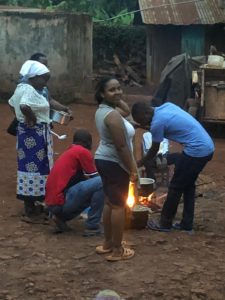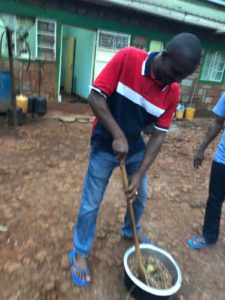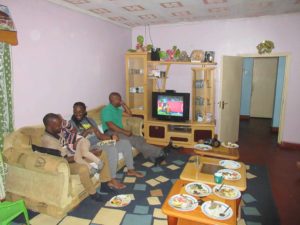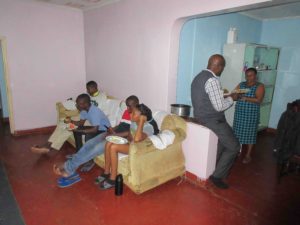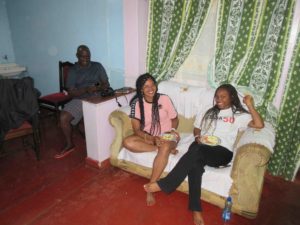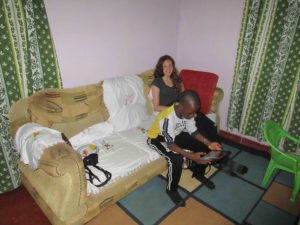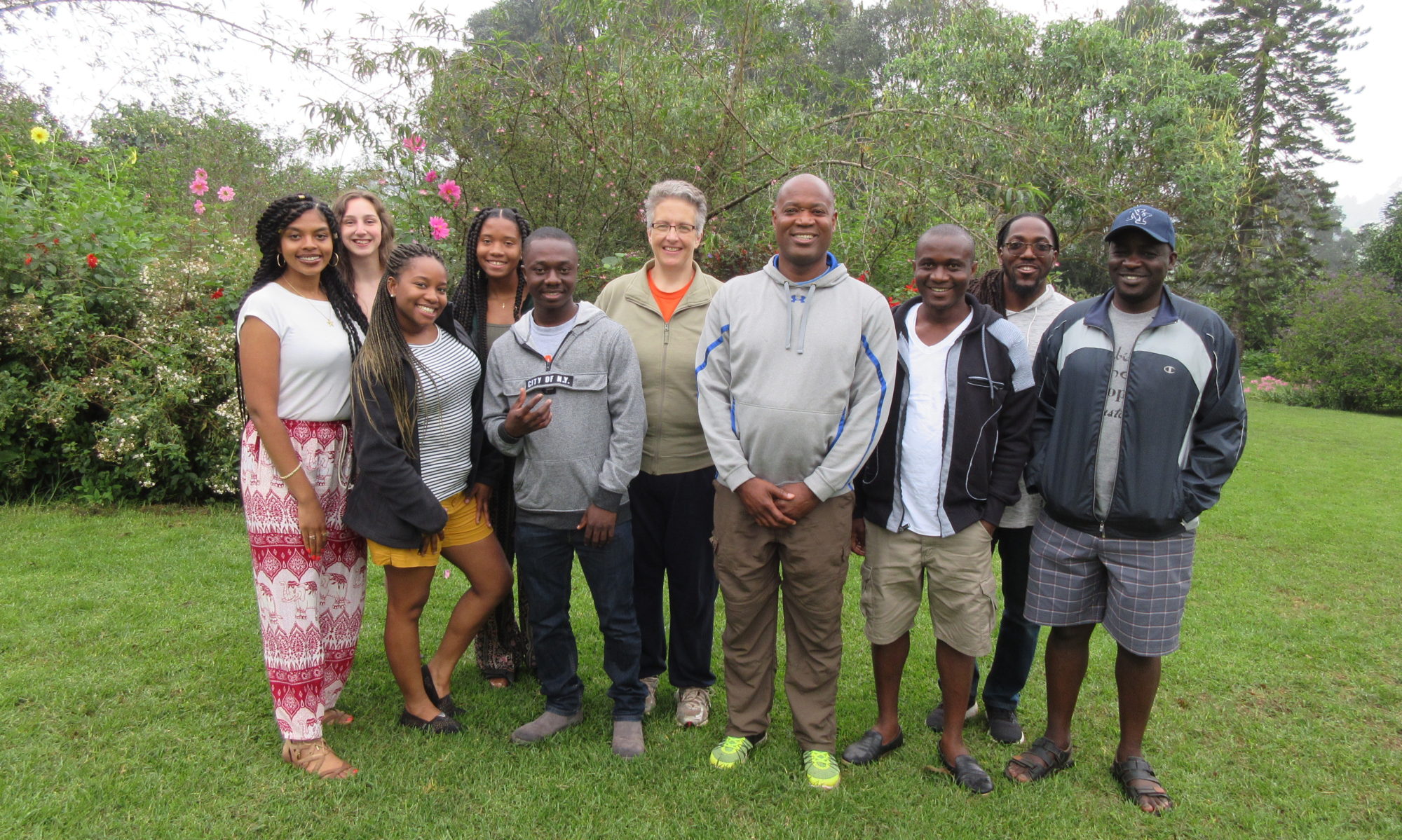Syracuse University School of Education ran a news story on our study abroad course.
Day 15: Travel to Nairobi, the Giraffe Centre, Kazuri Beads, and traveling back to the U.S.
We traveled back to Nairobi today and discussed our last class readings on the bus.
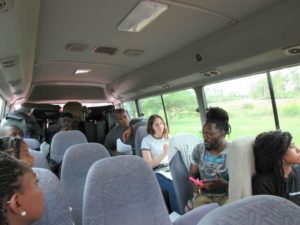
We stopped at the African Fund for Endangered Wildlife Giraffe Centre and fed the giraffes and learned about the three different types of giraffes that are present in Kenya (Maasai, Rothschild, Reticulated) and how the center was established to protect, breed and reintroduce the endangered Rothschild giraffe that was originally found in western Kenya.
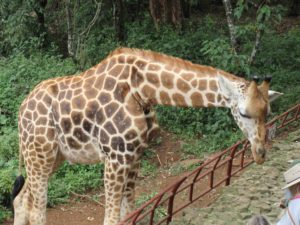
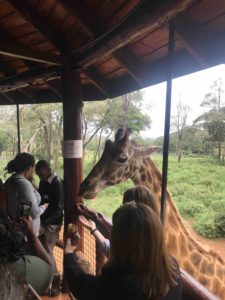
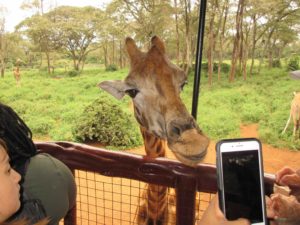
We then went to Kazuri Beads and had a tour to learn about the process of obtaining clay, making the clay usable, making beads and pottery, firing the clay, painting and glazing, and finishing the products. Kazuri means “small and beautiful” in Kiswahili and these products certainly live up to the name.
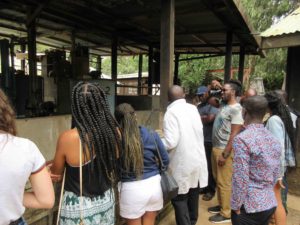
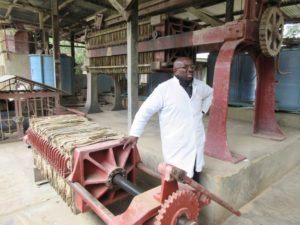
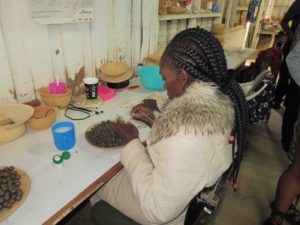
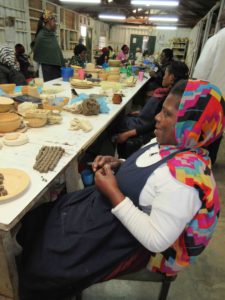
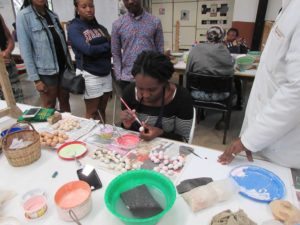
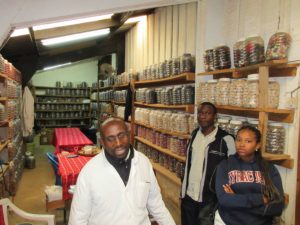
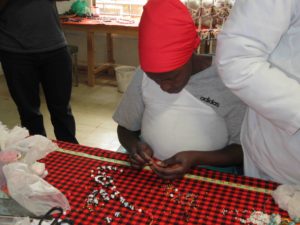
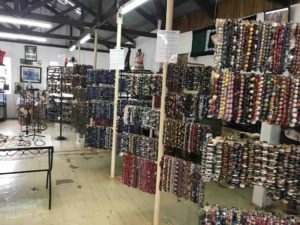
We stopped at The Hub for lunch and a bit of shopping. We then went to Joanna and Adamson’s home in Ngong to relax a bit before most of us traveled to the Jomo Kenyatta International Airport to fly back to the U.S. Before leaving for the airport, we took a final group photo.
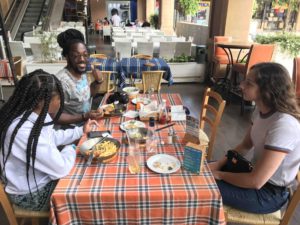
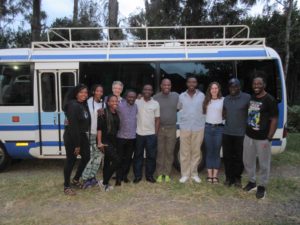
Kwaheri, Kenya! Tutarudi tena! (Goodbye, Kenya! We will come back again!)
Day 14: Final day with students and teachers in Embu town
Today’s blog post is written by one of the faculty leaders of the study abroad course.
Name: Jeffery A. Mangram
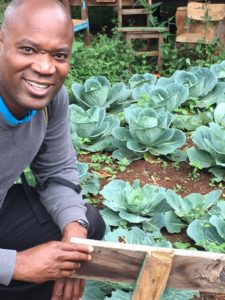
Hometown: Brunswick, Georgia
Position: Associate Professor of Social Studies Education; Director of the Media and Education Program; Provost Faculty Fellow
I am teaching and co-leading the Kenya study abroad experience because I want SOE students (and myself) to broaden and deepen their perspectives about themselves as well as how they come “to know” something about another culture. That is, I want the Kenyan experience to serve as a mirror that motivates us to examine the perspectives we have about ourselves, Kenyan students, Kenyan teachers, education broadly defined, the nation of Kenya, the continent of Africa and the U.S.
Some things I have observed thus far are the tensions around continuity and change that the nation of Kenya is experiencing at many levels. For instance, while the Kenyan Federal Constitution, which was rewritten and adopted in 2010, is a marvelous document that outlines the hallowed principles of governance, individual rights, and rule of law, there is continued political corruption and scandals. Additionally, for instance, the Kenyan national government continues to build their national infrastructure (i.e., national highways, water systems, and railways) while at the same time continuing to conserve vast wildlife sanctuaries and national parks. While the derogatory term “tribe” has been changed to “communities” or “ethnicities” to describe the 43+ communities who have traditionally inhabited Kenya as well as signal positive cohesion and unity, their separateness in terms of community language (dialect), political behavior, and geographical cohesion remains intact. And while the Kenyans gained their independence from the British in 1963, the vestiges of British imperialism are replete, from what side of the road one drives on to the educational system used to educate Kenyan children, from the British-built Parliament where the Kenyan legislature meets to the British-built dormitories where Kenyan students lay their heads at the National schools they attend. Continuity and change. Continuity and change.
I find it interesting that the educational leaders have decided to move from a single, high stakes examination model to a more competency-based model. I say this because the educational leaders are realizing that attaining knowledge alone is not enough. Knowledge needs to be applied, and applied in new and novel ways. Understanding that technological innovations are accelerating all aspects of life has motivated this shift. Additionally, it is interesting that the educational leaders have not outlined the outcomes of the competency based model. What outcomes should be outlined in this ever changing world? Should the outcomes be geared in economic terms? Civic terms? Artistic terms? Ethical terms? Technological terms? What should a Kenyan student be able to know, do, and understand in this ever changing world? These are not easy questions to answer, thus the slow walk on the part of these leaders.
I am looking forward to talking with the SOE students about this experience three or four months from now. What has changed in them? How do they now make sense of U.S. educational systems after this experience? What do they miss about the Kenyan people? How have they applied this experience to their lived U.S. experiences now?
Recap of Today’s Activities:
We were again at Kangaru School today to observe students and teachers. Some of the SOE students and faculty members taught lessons. Some students had an opportunity to explore other areas of the campus. Easton Davis, Isabel Fabre, and I were given a tour of the student dormitories, the cafeteria, and the working farm on the campus.
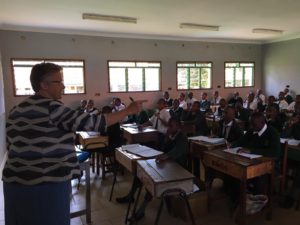
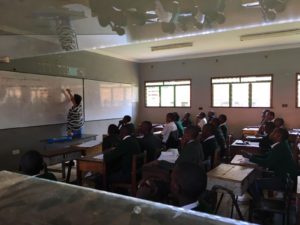
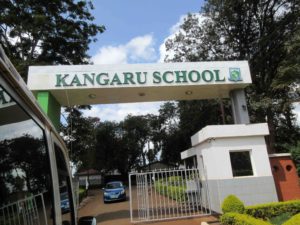
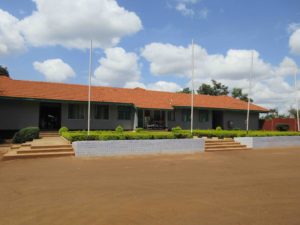
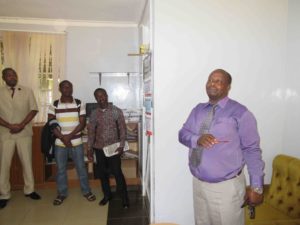
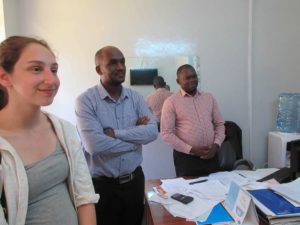
The young men’s dormitories are situated in barrack-style formations or quad-style situations, depending on what year they were constructed. Each dormitory holds 200 young men. There are communal showers and bathrooms. Each young man sleeps in a bunk bed, with the senior student sleeping on the bottom and the junior student on top. Each student has a foot locker in which to place their belongings.
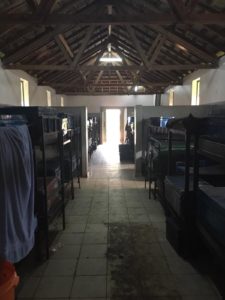
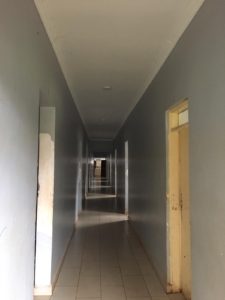
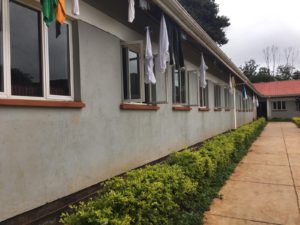
Someone has to feed 1,500 young men and about 100 teachers, staff and administrators. The cafeteria staff is charged with this task. As we visited the kitchen, I observed about 10 huge vats the size of three washing machines used to cook rice and cabbage! Amazingly, all of these vats are fired with cooking wood! The staff have to cook three meals for the young men seven days a week! Next, we visited the bakery, where there were loaves and loaves of bread as well as lots of bread dough to make more!
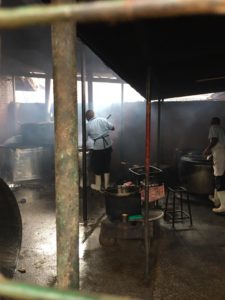
The school has a working farm that we visited. After learning that the national exams requires that every student must pass an Agriculture component in which the student has to prove that they can cultivate and grow a garden of some food, we actually went and looked at some of the cabbage plots that students had grown. Furthermore, we saw fields and fields of maize! The school has cows, chickens, turkeys, and hogs that are used to feed the young men, though the students are not required to care for the animals.
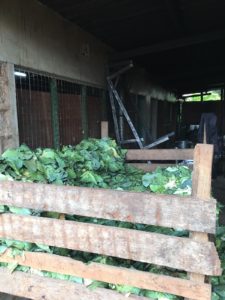
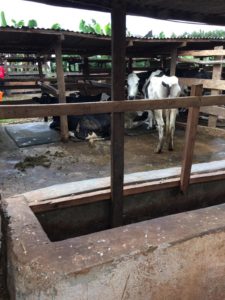

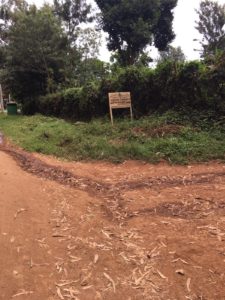
After the tour, I was able to observe a Form 3 (our 11th grade) History class in which the history of Pan-Africanism was discussed. The founder of Pan-Africanism, W.E.B. Dubois’, name was invoked as well as how he assisted in organizing the NAACP. The class discussed why and where the first Pan-African Conference was held. Convened in London in 1900, the first Pan-African Conference aimed to understand the experiences of African people throughout the world, with the goal of mitigating the colonial exploitation and racism that they were experiencing in different contexts.
Finally, after the tea break, I observed Tiffany Hamm, a doctoral student in the Science Education program, teach a biology lesson to Form 1 students on the “Mechanisms of Gaseous Exchanges in the Gills of Bony Fish.” Having the students first engage with specimens of fish gills in a petri dish, Tiffany encouraged the students to enumerate things they observed about the gills and what questions they had about them. Next, using an interactive lecture, Tiffany guided the students through the gaseous exchanges that occur with a fish in water. Tiffany posed numerous questions as she explained various processes, encouraging the students to ask and answer their own questions. At times, she asked the students to make connections with previous lessons. She showed a YouTube video of a fish breathing to underscore the gaseous exchanges that were occurring. She ended the lesson by circling back to the very questions the students generated at the beginning of the lesson. The students now answered these questions based on the information they gained from the lesson. Kudos to Tiffany for teaching such a fantastic lesson! ‘Cuse in Kenya contributing!
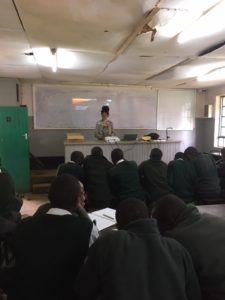
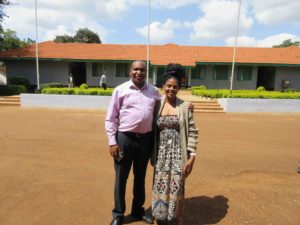
In the evening, we were hosted at the University of Embu by Vice Chancellor Professor Daniel Mugendi. There were remarks by Prof. Mugendi, Dr. Peter Rugano, Dr. Ciriaka Gitonga (Dean of the School of Education and Social Sciences), the Syracuse University team, Prof. Kiplagat Kotut (Deputy Vice Chancellor for Academic Affairs, Research, and Extension), and Prof. Eucharia Kenya (Deputy Vice Chancellor for Planning, Administration, and Finance). As always, we are thankful for the skilled driving of our bus driver, Nafton.
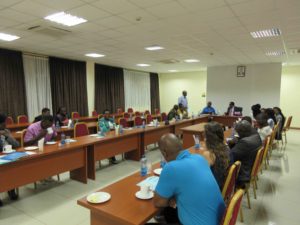
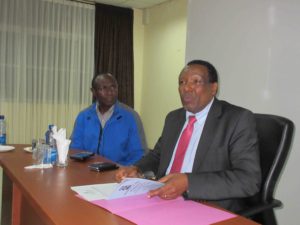
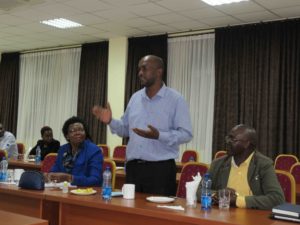
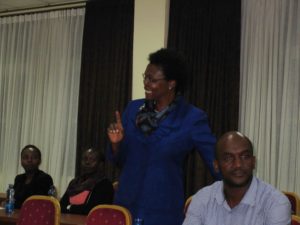
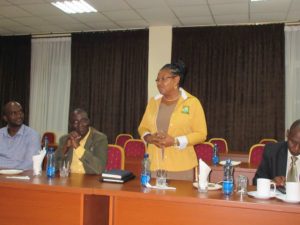
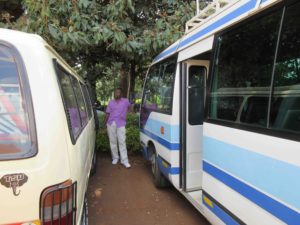
Day 13: Continuing to learn from students and teachers in Embu town
Today’s blog post is written by one of the students in the study abroad course.
Name: Crispin Ojwang
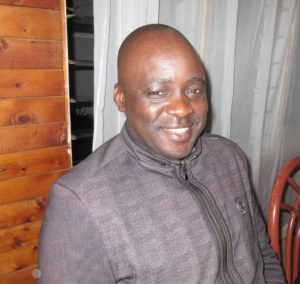
Hometown: Kisumu, Kenya
Year and Program of study: I am a third year PhD student in the Teaching and Curriculum program.
I am participating in the Kenya study abroad experience because I wanted to experience education in Kenya through a different lens. Prior to joining the PhD program in Teaching and Curriculum at Syracuse University, I taught English and Literature in a public high school in Kenya and therefore had quite some insider experience while embarking on the study abroad experience. But having learned a lot on education from my program, I was interested in experiencing the education system in Kenya again and comparing what was going on with how I had experienced and understood it before, especially with different perspectives from course mates of different nationalities A new curriculum, the Competency-Based Curriculum, had also been introduced and I was interested in seeing how it pans out.
Some things I have observed thus far are the inequality that still seems to play a big role in education in Kenya, the significant challenges in education for students with disability and the gradual progress of technology integration. Having observed both a small rural day school and a large urban boarding school, the differences seem so pronounced in terms of facilities and human resources and the gap does not seem to be narrowing fast enough. I have also observed that there is still a long way to go in providing quality education for students with disabilities especially in high school. Technology integration is also still in the early stages despite being widely acknowledged as a feasible way of improving student learning.
I find it interesting that some of the things I observed or did in the past, that looked so usual when I learned and worked in the Kenya education system, look a little different today with my new educational lens coupled with the experiences and perspectives of my course mates from different countries, as well as the number of years that have gone by. For example, while in the past I viewed the small rural under-resourced schools as a ‘good enough’ option of providing some basic education for those with almost no access, the perspectives of my course mates have made me begin to think about these students as losing out on quality education compared to their peers in better resourced institutions.
I am looking forward to learning more about the experience of my course mates from different countries, of education in Kenya and everything else including the people, vegetation, climate and the food among other things. I also look forward to learning from their perspectives and I am curious to see what suggestions and input they may have for rural and urban education in Kenya.
Recap of Today’s Activities:
After a nice and refreshing weekend vacation, today seven out of ten members of the SU study abroad team including our leaders Profs. Joanna Masingila and Jeff Mangram returned to Kangaru School for the Day 2 visit. Three members, Ptahra, Carly and Isabel returned to ACK St. Monica Embu Special School to observe and work with teachers and students with disabilities.
We arrived quite early at Kangaru and waited in the bus for the morning assembly to end. As soon as it ended, members of the team went to the staffroom to meet the teachers and embarked right away on various activities with the teachers and students. Some members of the team went into the classrooms to observe or teach while others interviewed teachers on various aspects of education that were of interest to them. I had the opportunity to teach two Form 4 English classes and a Form 1 English class.
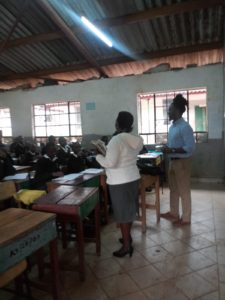
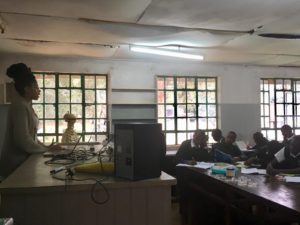
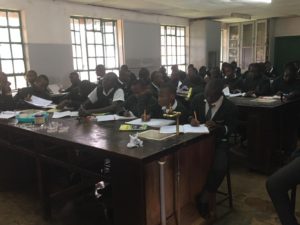
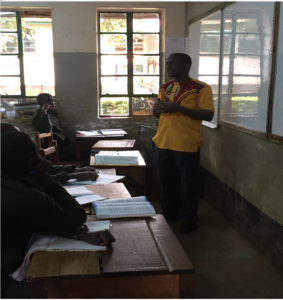
These activities went on until the tea break when together with the teachers, we enjoyed tea and some tasty mandazi. Members of the team continued teaching, observing and discussing with the teachers until the lunch break at 12:40 pm. The three members who had been at ACK St. Monica joined the rest of the team at Kangaru. We were treated to a sumptuous lunch of rice, beef stew and cabbage. The SU team left Kangaru school at 1:30 pm to return to their base at Izaak Walton Inn in Embu town. I was left behind to teach an English class between 1:30 pm and 2:50 pm before later joining the rest of the team at Izaak Walton Inn. It was a busy and interesting day as members went on with their activities and also began to consolidate ideas on what they had observed during their time in Kenya and in the schools as we approach the end of the study abroad experience.
We enjoyed dinner at the Izaak Walton Inn, where we hosted Mrs. Njeru, one of the Kangaru teachers, and her husband, Mr. Njeru, who is a teacher at another secondary school.
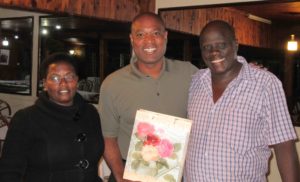
Day 12: A trip to the Mount Kenya region
We left The Ark this morning and went on a bus back to the Aberdare Country Club, where we met Nafton, our bus driver, and headed for Nanyuki. We stopped at the equator for some pictures and heard and saw a demonstration from a man wearing a Chicago Cubs jacket about the coriolis effect on water 20 meters north of the equator (water rotates in a clockwise motion when falling downward), 20 meters south of the equator (water rotates in a counter-clockwise motion when falling downward), and at the equator (water does not rotate at all).
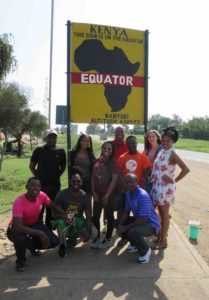
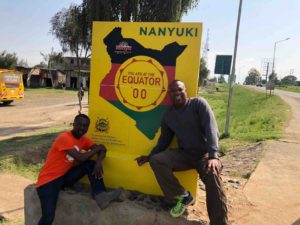
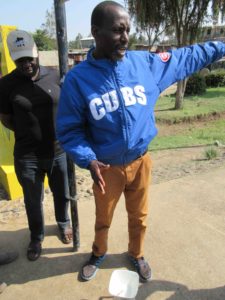
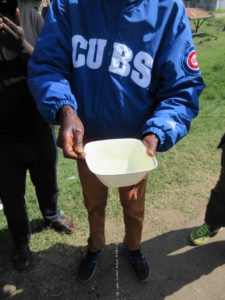
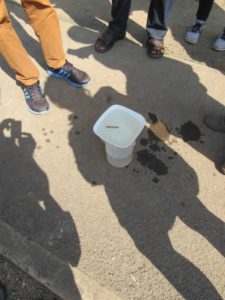
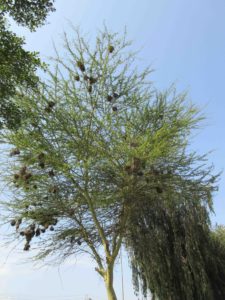
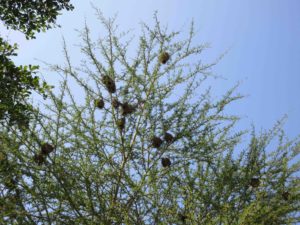
We then went to the Mount Kenya Wildlife Conservancy and Animal Orphanage. Our guide, Benson, showed us all of the animals there, many of whom were orphaned and will be released back to the wild. There are bongo and cheetah breeding programs here, as well as different types of monkeys, several ostriches, tortoises, a baby zebra, bush bucks, a porcupine, forest pigs, pygmy hippos (a gift from West Africa), llamas (a gift from South America), and other animals that are used in educating school children and other visitors about wildlife conservancy in Kenya.

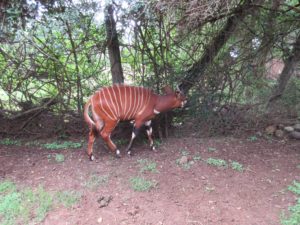
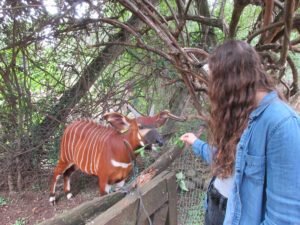
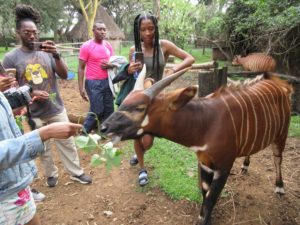
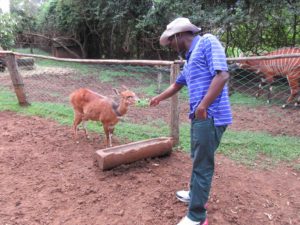
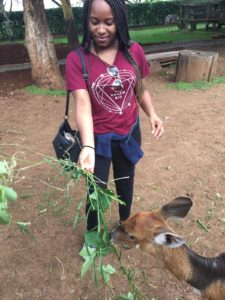

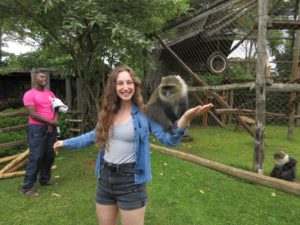
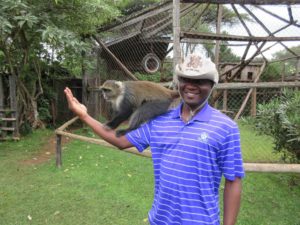
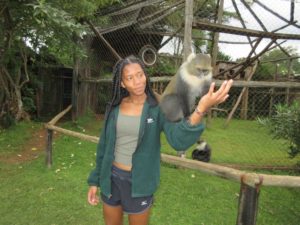
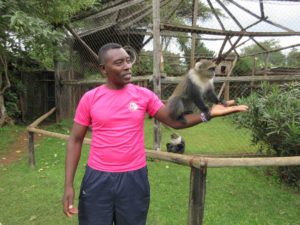
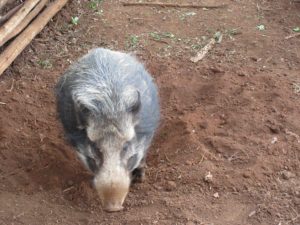
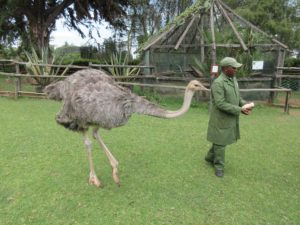
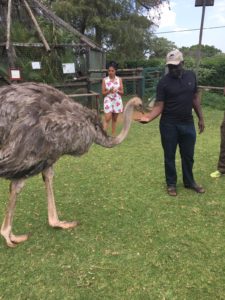
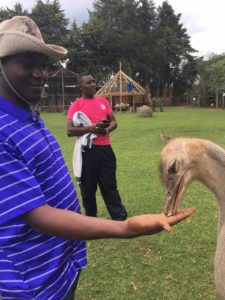
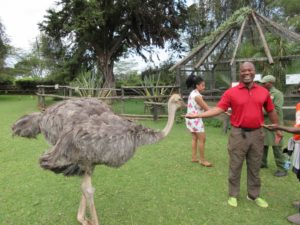
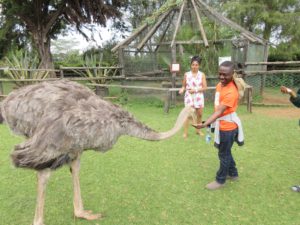
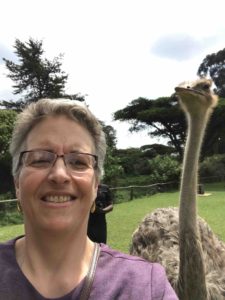
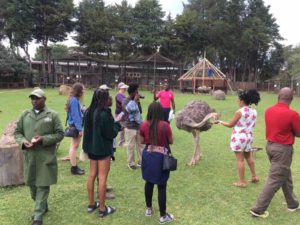
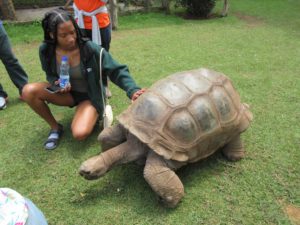
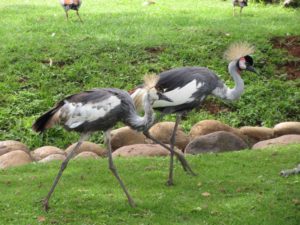
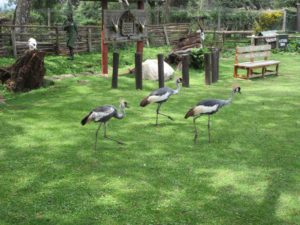
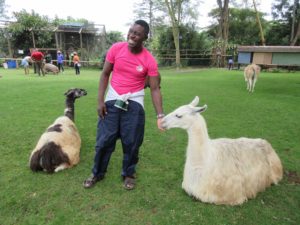
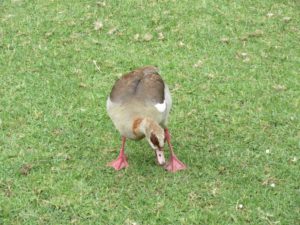
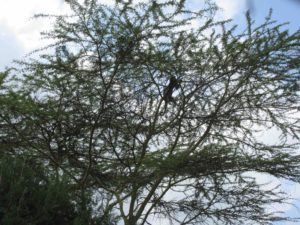
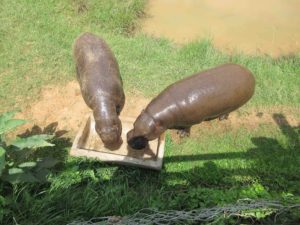
On our way back to Embu, we stopped for lunch at the Trout Tree restaurant and had a delicious meal. This restaurant is unique in that it is built in and around a huge mugumo tree and serves fresh trout from the trout ponds that are on site. Tree hyrax, Colobus monkeys, and birds can be found on the Trout Tree grounds, along with trout.
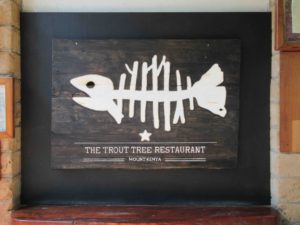
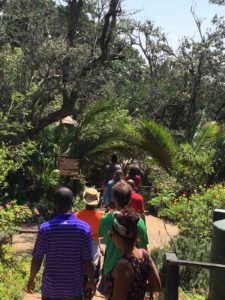
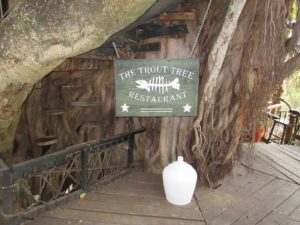
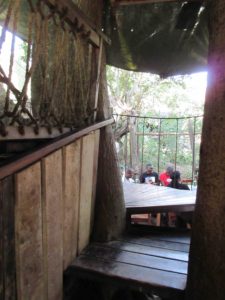
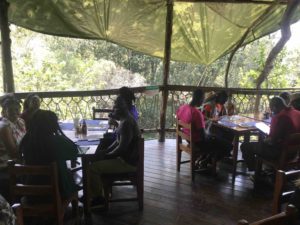
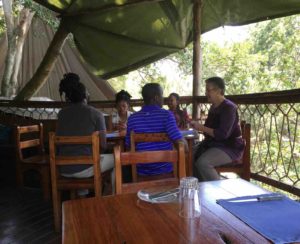
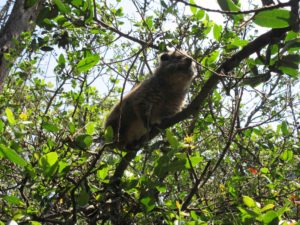
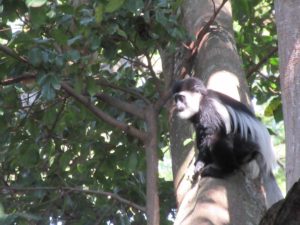
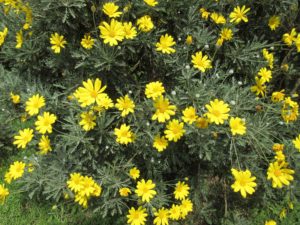
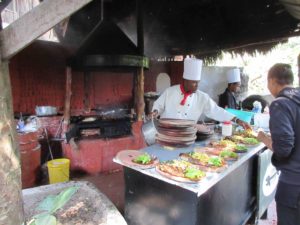
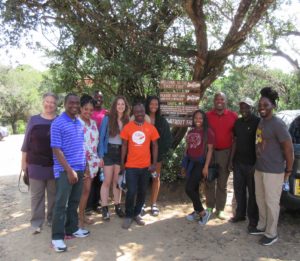
Below are a few photos of some of the sights we saw as we drove from Nanyuki back to Embu this afternoon.
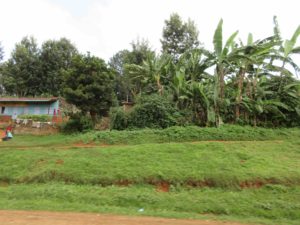
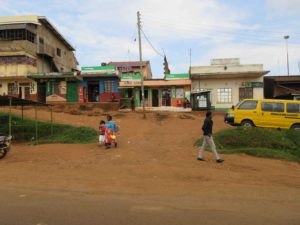
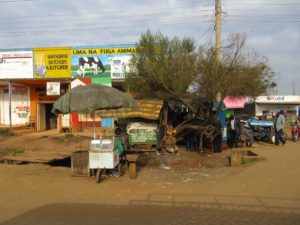
After the satisfying meal, most of us took a nap in the bus as we drove back to Embu.
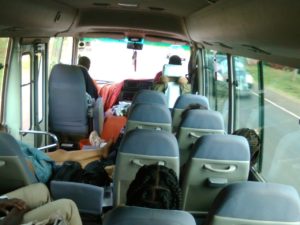
Day 11: A trip to the Aberdares
Today, we left Embu soon after 8:30 am and traveled about 2.5 hours to the Aberdare Country Club in Nyeri County, stopping to pay entrance fees for the Aberdare National Park first. At the Aberdare Country Club, we went with a naturalist guide to the game sanctuary that is on the property and saw wart hogs, giraffes, elands, olive baboons, and zebras.
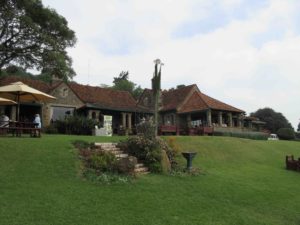
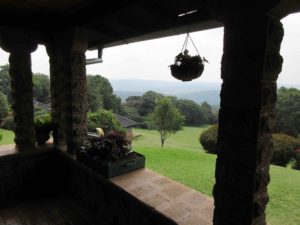
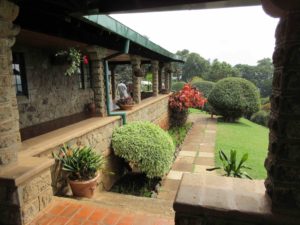
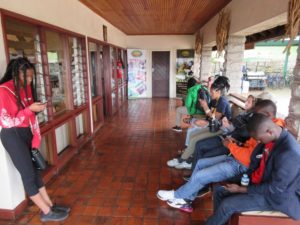
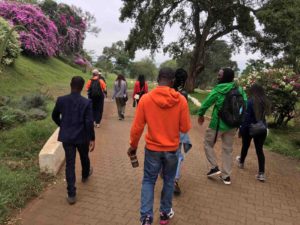
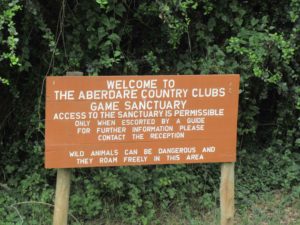
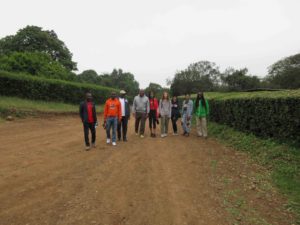
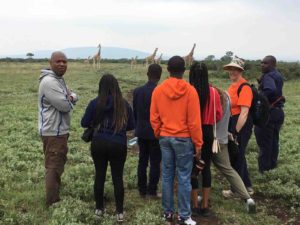
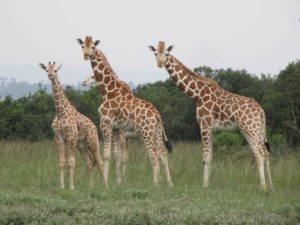
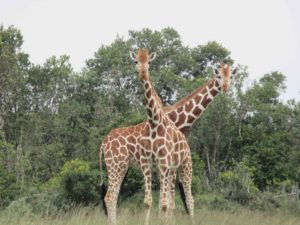
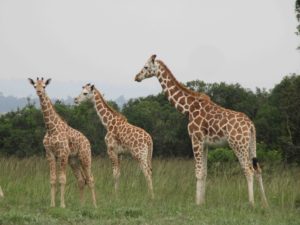
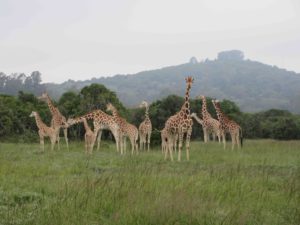
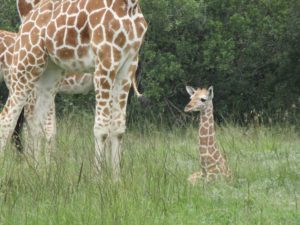
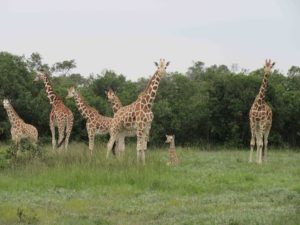
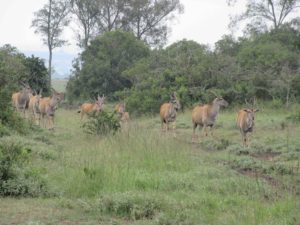
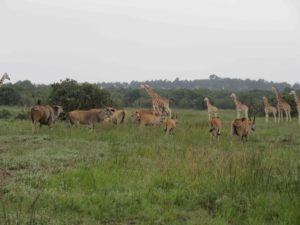

After the walk in the game sanctuary, we had a delicious lunch and enjoyed the flowers on the grounds of the Aberdare Country Club.
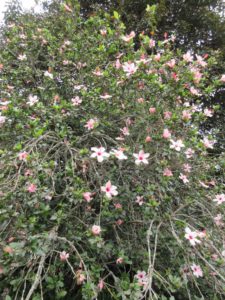
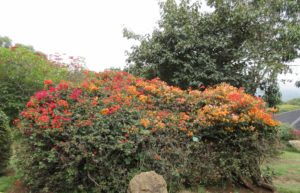
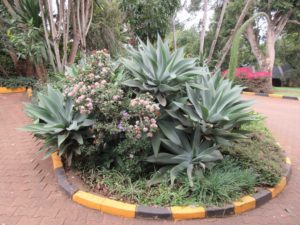
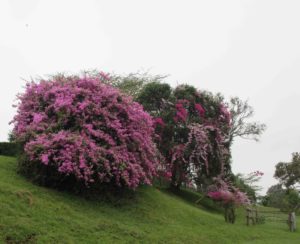

We then got on a bus that took us into the Aberdare National Park to The Ark Lodge. On the way to The Ark, we saw some Cape Buffalo.
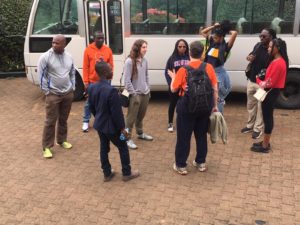
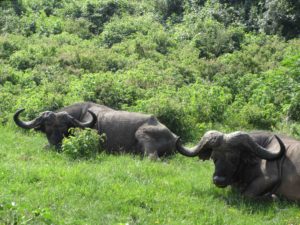
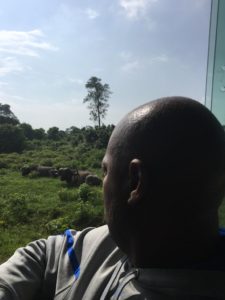
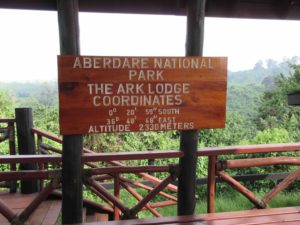
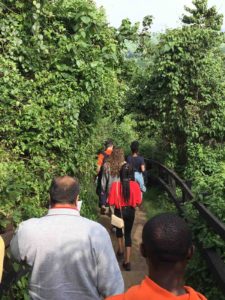
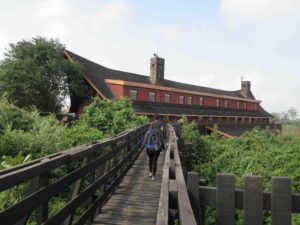
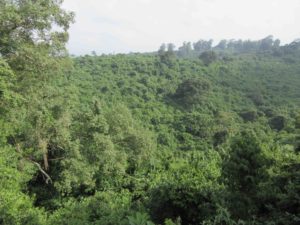
At The Ark, we sat on the viewing decks and saw many different kinds of birds, giant forest hogs, Cape buffalo, elephants, bush babies, and hyenas.
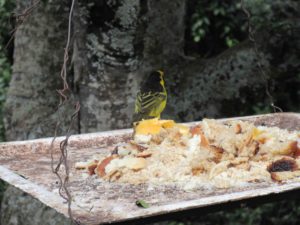
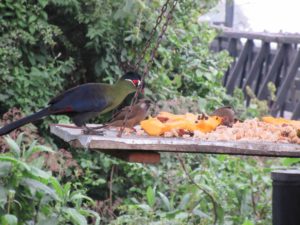
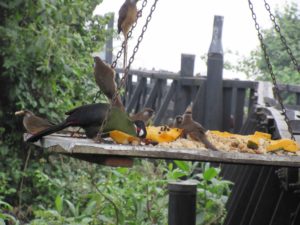
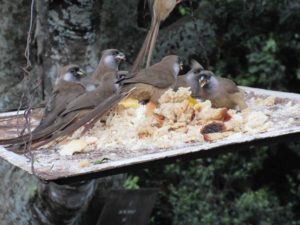
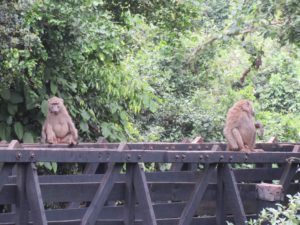
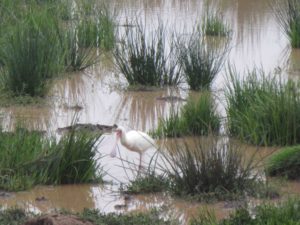
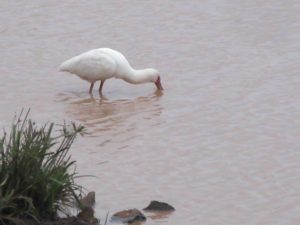
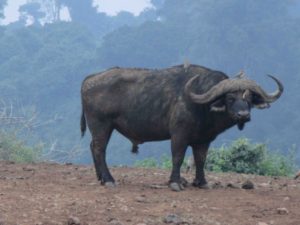
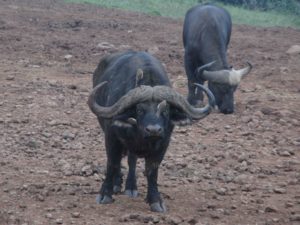
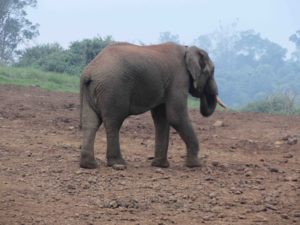
At The Ark, we had a talk by one of the staff members about the history of The Ark and the animals in the area. We had a good dinner and enjoyed drinking tea and coffee into the evening while watching animals. Then we retired to our rooms for the night.
Day 10: First day of interacting with teachers and students at schools in Embu town
Today’s blog is written by one of the students in the study abroad course.
Name: Carly Cannon
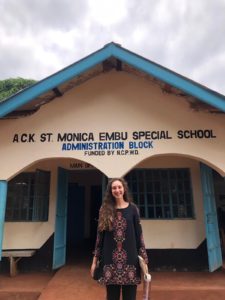
Hometown: Portland, Oregon
Program of study: I am starting my third semester of the Master of Science in Cultural Foundations of Education program and Certificate of Advanced Study in Disability Studies this fall and plan to graduate in December of 2019.
I am participating in the Kenya study abroad experience because much of my undergraduate research experience involved information from Central and East Africa. Currently, I work with students, many of whom either speak Kiswahili or actually lived in Kenya for a portion of their lives. In an attempt to connect with these students and to try and incorporate more of their background into lessons, I thought that this experience would be very beneficial for me. Additionally, as an advocate for disability rights – particularly in relation to education – I wanted to learn more about how the special education system works in the Kenyan context.
Some things I have observed thus far are that Kenya is a very beautiful country with beautiful people. I have greatly enjoyed Kenyans’ hospitality and sense of humor. In terms of the classrooms we have been observing in, I have been almost exclusively been observing the special education programs. The linkages between poverty and disability are not foreign to me, however, the social impacts that operate between the two have been interesting and humbling to observe. The stigma of disability runs deep in Embu County, and presumably throughout Kenya. Although, I would argue that globally (the United States included) we have much to aspire for before we reach true inclusion. With this stigma in Kenya, however, this creates challenging ties with family members and the financial component only increases this dynamic. Additionally, families who would be interested in advocating for their children appear to be constrained based on their lower financial standing. This, as a result, creates limited opportunities for students with disabilities’ voices in their communities.
I find it interesting that during our time at the Ugweri primary school’s special education classroom, it did not seem like anyone outside of that classroom knew anything about the students with disabilities – not their names or where they went to class, let alone what each student was capable of doing. However, at the ACK St. Monica Embu Special School in Embu town, it was much different where all of their services are centered around students with disabilities; channeling what skills the students have an interest in obtaining and finding ways to work with each students’ disability. We were shown what products students are creating in their programs, which represent marketable skills for the community. This represents what can happen when there is support for students and their success.
I am looking forward to learning more about what teaching practices teachers use at the special education school in Embu, and to learn further who determines and distributes funding to these programs.
Recap of Today’s Activities:
Today, we started our day off at Kangaru Boy’s School (a boarding school with about 1, 500 students) in Embu town. We attended their parade (held each Monday and Friday) and were presented to the students and administration. Following the parade, we enjoyed tea and snacks in the Chief Principal’s office and discussed the functions of Kangaru.
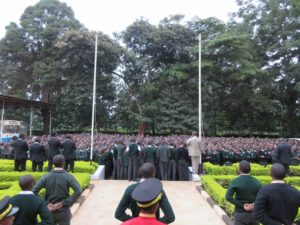
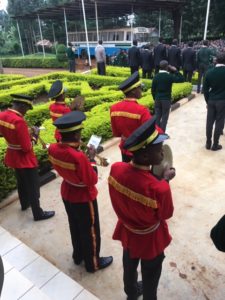
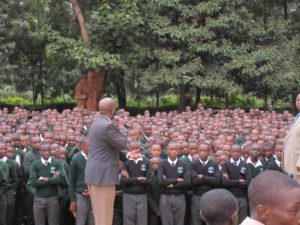
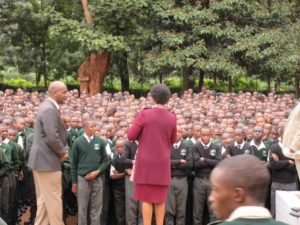
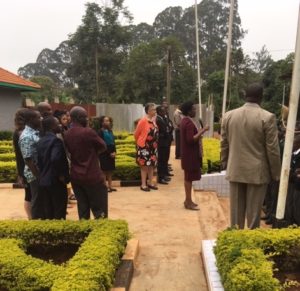
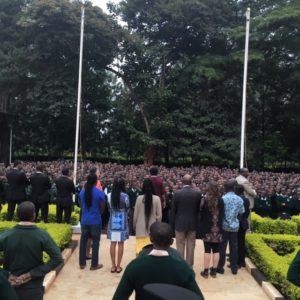
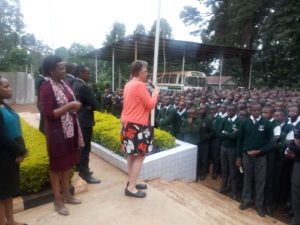
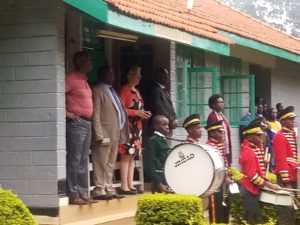
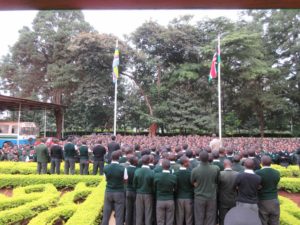
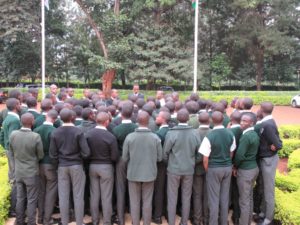
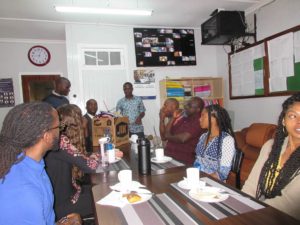
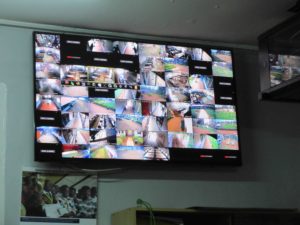
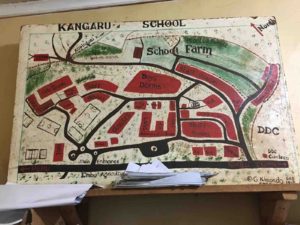
After learning a little more about the operations of the school, all except three of our group went off to observe in classrooms in Kangaru. The three students who did not go to observe in Kangaru (myself included), went to another school dedicated to students with disabilities called the ACK St. Monica Embu Special School. We were taken around to the different classrooms and interacted heavily with the faculty, learning from their experiences and what their roles each were within the school.
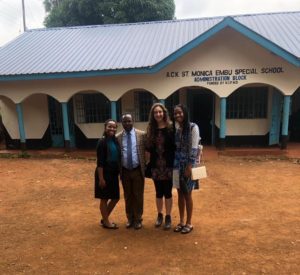
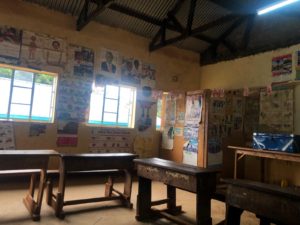
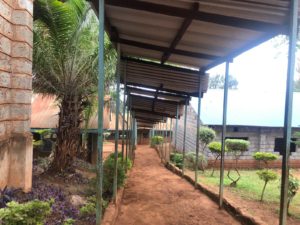
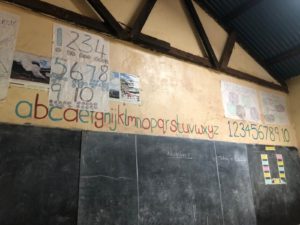
In the early afternoon, we all reconvened at Kangaru where we were hosted for lunch with the teachers. We had a delicious meal of beef stew, cabbage, and ugali. We then left for the hotel so that students would have time to work on assignments and readings for this course, as well as rest and relax. For the remainder of the day, we focused on studying and exploring the grounds of Izaak Walton Inn where we are staying, ultimately ending the day with a group dinner at the hotel’s restaurant.

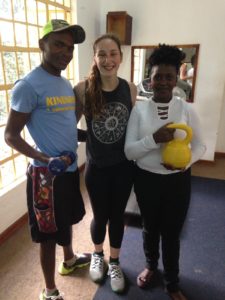
Day 9: Changing Locations and Interactions at University of Embu
After four days in Ugweri, our group moved to Embu town. We took a group photo with a number of the host families last evening and also took some photos this morning with the host families for our students and the person who cooked for us while we were in Ugweri.
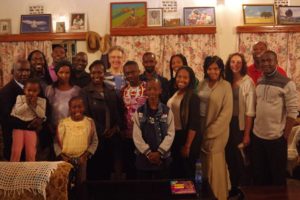
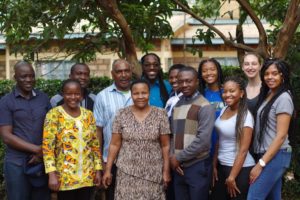
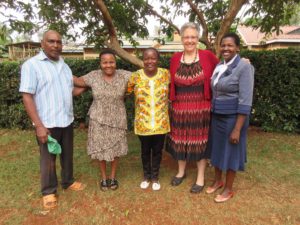
When we arrived in Embu town around 9 am, we checked into the Izaak Walton Inn and had some time in the morning to work on course readings and assignments.
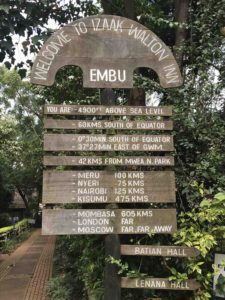
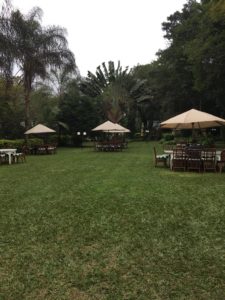
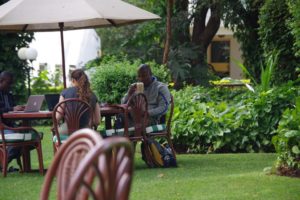
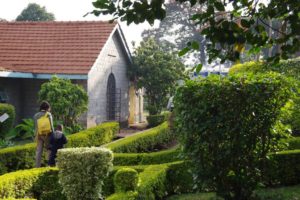
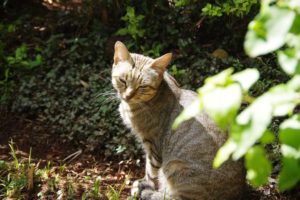
We ate lunch at the Mountain Breeze Hotel and enjoyed the sunshine.
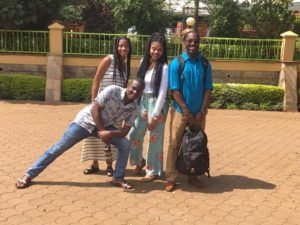
After lunch, we went to the University of Embu where Dr. Ciriaka Gitonga, Dean of the School of Education, and Dr. Peter Rugano, Lecturer in Science Education, engaged us in critical thought and discussion about education in Kenya.
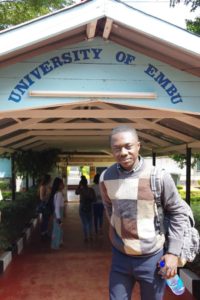
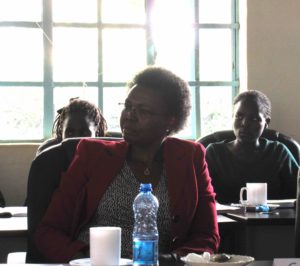
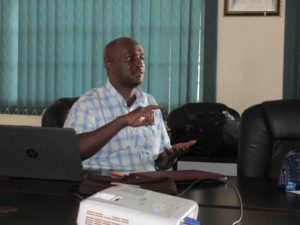
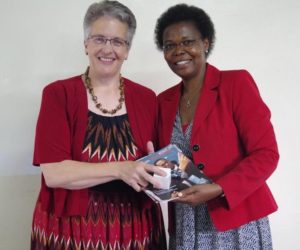


We close today’s blog with a photo we saw on a high school campus that reflects the growing awareness in Kenya of difference and the need to support all learners.
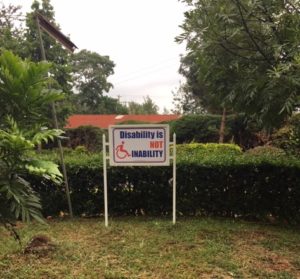
Day 8: Final day with students and teachers in Ugweri
Today’s blog post is written by one of the study abroad students.
Name: Ptahra Jeppe
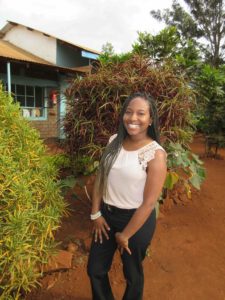
Hometown: Brooklyn, New York
Year and Program of Study: In final year of the JD Law program, the MS in Cultural Foundations of Education program, and the Certificate of Advanced Studies of Disability Studies program
I am participating in the Kenya study abroad experience because I am interested in learning and studying cultures different from my own. I am interested in disability in the global context and I am excited by the idea of being able to study special education in Kenya and to learn from the people of Kenya in general.
Some things I have observed thus far are the lush landscape, beautiful flowers and fruits and vegetables. I have observed the contrast of the tall buildings and metropolitan feel of Nairobi with the smaller homes and buildings and the agricultural landscape of Embu County.
I have found it interesting to participate in the special education class in Ugweri Primary School. There were many commonalities in the challenges that children in special education face in Kenya and abroad, as well as challenges unique to this community. I am fascinated to learn from the special education teacher who, with minimal resources, has transformed the lives of her students. For example, she has built homes, bathrooms and water tanks for some of the students, she has created vegetable gardens for each child’s home, and has started a program where she engages the students in cooking a meal every day for their lunch. For some students, this is their only meal of the day. When my classmates and I entered this new space, everyone (as might be expected) was nervous about what the three days in the special education class would bring. The students, however, quickly began to open up and share with us what they have learned. We were able to share in the joy and excitement of one student learning how to thread a needle and begin to sew, a task he had not been able to tackle previously. This skill of hand-eye coordination was not only realized, but this is a vocational skill that will allow this student to provide for his family and contribute to his community. Watching the community’s attitudes toward the students we got to know evolve was an honor to experience, given the fact that there are families that keep students with disabilities at home and the school seems not to understand how truly capable the students in the special education class are and what they have to offer the community.
I am looking forward to keeping in touch with the special education classroom and finding ways that I and my community back home can support them. I am also looking forward to our next school experience in Embu town.
Recap of Today’s Activities:
We were at the schools in Ugweri again today. At the primary school, the day started with an assembly. The special education class worked together to cook their meal. After lunch, there was a classroom available for them to use in the school and they engaged in a lesson. Some of us visited other classes in the morning in the primary school and talked with the students and answered their questions. At the secondary school, members of our group observed classes and several taught classes.
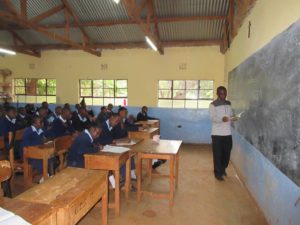
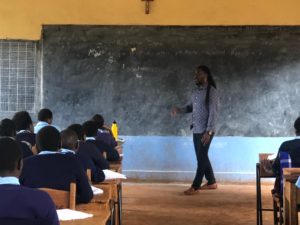

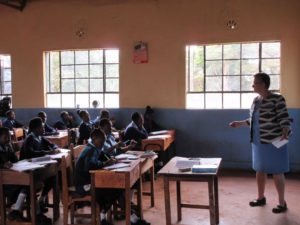
During the morning tea break, Garmondyu and I had an opportunity to discuss the importance of incorporating technology into the classroom with the secondary teachers, and the benefits of assistance technology.
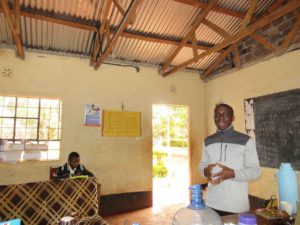
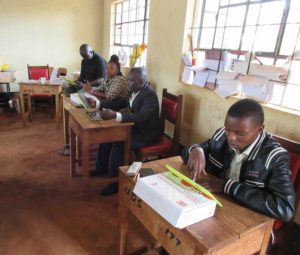
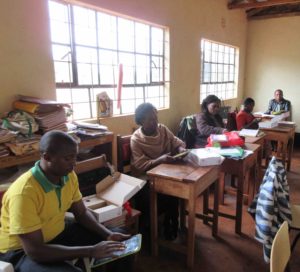
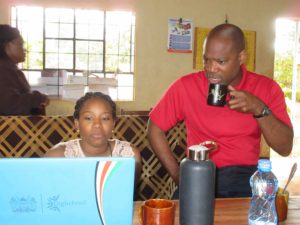
Over lunch break, the principal, Mrs. Muli, and Peter Rugano, one of the school board of directors, spoke, and two members of our group also spoke, thanking the teachers and students for welcoming us and allowing us to observe and teach students. We then took some group photos with the teaching staff.
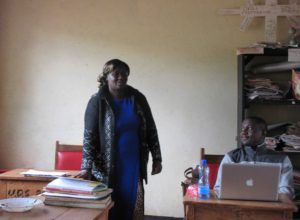
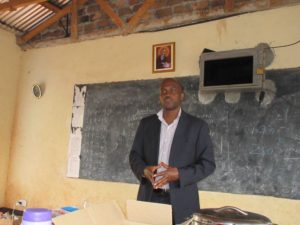
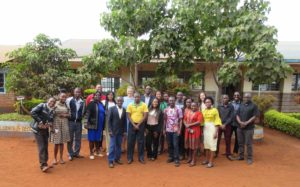
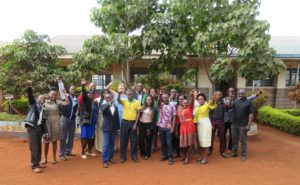
We very much enjoyed our time at the two schools in Ugweri. Below are some additional photos from our time together with these students and teachers.
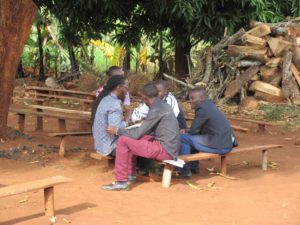
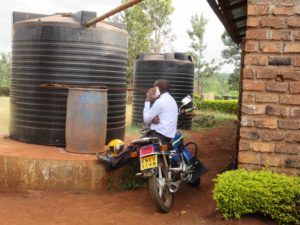
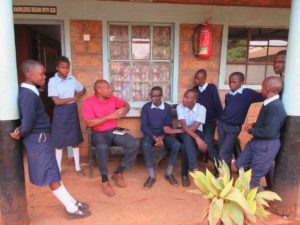
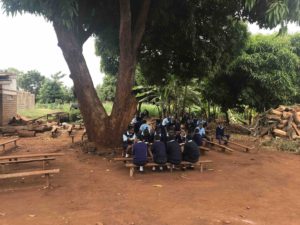
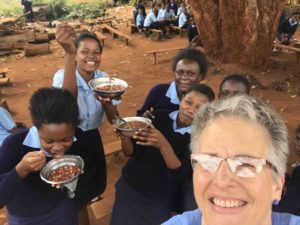
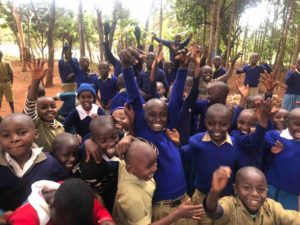
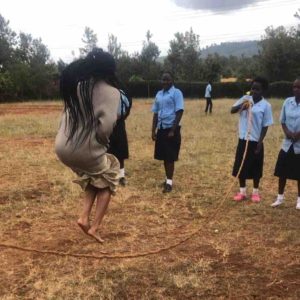
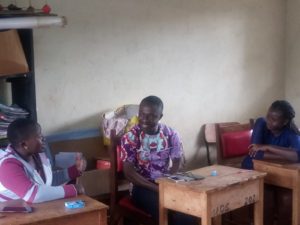
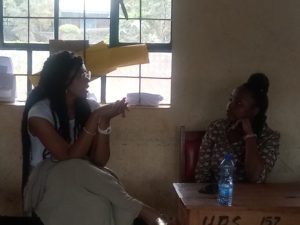
In the evening, we all participated in a celebratory dinner at one of the host family’s homes. We have greatly enjoyed our time with our host families and appreciate their warm hospitality.
Day 7: Continuing to learn from students and teachers in Ugweri
Today’s blog is written by one of the students in the study abroad course.
Name: Tiffany Hamm (Twitter: @TiffanyAych)
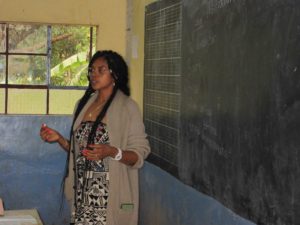
Hometown: the Bronx, New York City
Year and Program of study: Finishing first year in the Ph.D. Science Education program
I am participating in the Kenya study abroad experience because I wanted to explore the ways in which science education is carried within a different culture. Prior to attending Syracuse University, I taught Earth Science at a high school in the Bronx. During my years of teaching, I was committed to developing and strengthening my practice of teaching science. Ultimately, my goal was to increase the accessibility for science instruction for all learners found within my classroom located in an urban community. This includes English Language Learners, students with disabilities, students from low-income households, as well as general education students.
Some things I have observed thus far are the culture of schooling in a rural school in Kenya. In the back of the school, there is a small shamba (garden) full of fresh vegetables and legumes. Food is cooked daily at the school, and meals are eaten together. Personally, this provided a feeling a kinship among the teachers.
I find it interesting that there is no separation between (public) education and religion. Many schools within Kenya are sponsored by a church and therefore incorporate religion and religious studies within their curriculum.
So far, I have only observed education in a rural secondary day school. I am looking forward to observing science classrooms, and education in general first, in the rural primary school, and then in the urban national boarding secondary school.
Recap of Today’s Activities:
Today began with the SU crew visiting the rural schools; a few of us attended the St. Jerome Ugweri Secondary Day School and the remaining attended the Ugweri Primary School. While I was at the secondary school, I was given the opportunity to teach two biology classes; a Form 1 (freshman) class and a Form 4 (senior) class. Some other people in our group taught classes as well.
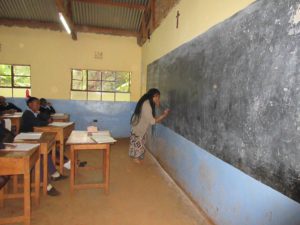
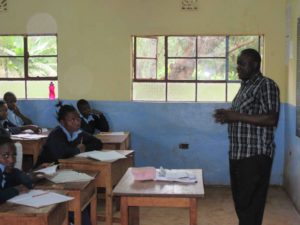
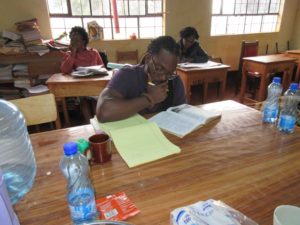
Three members of our group have been working with Mrs. Kamau in the Special Needs Education class at Ugweri Primary School. They went with her and the students in the class on the Tuesday visits to each home of the students in the class. The primary students were thrilled to ride in our bus for the home visits.
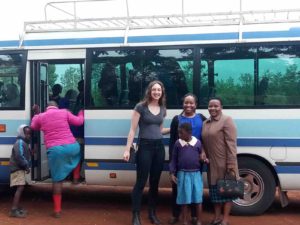
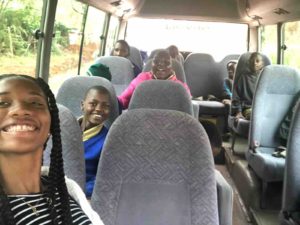
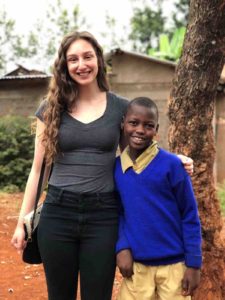
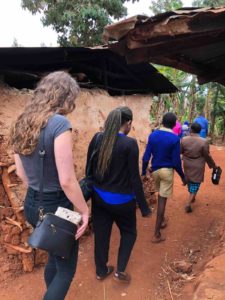
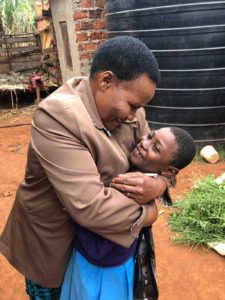
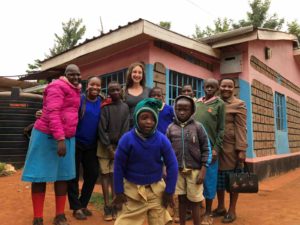
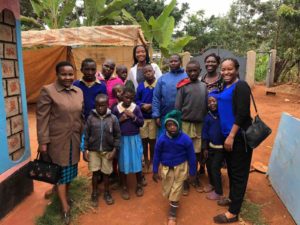
Our leaders, Joanna Masingila and Jeff Mangram, spent the morning with Dr. Peter Rugano, a lecturer at the University of Embu, observing three student teachers from the University of Embu teach lessons during their teaching practice at Moi High School, which is near to Ugweri.
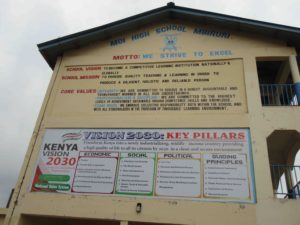
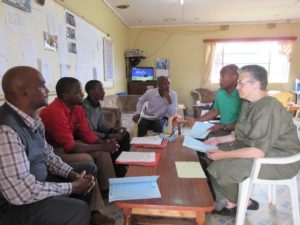
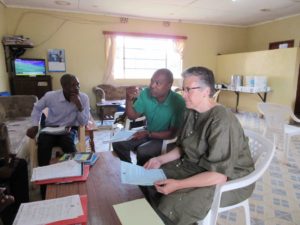
After the school day ended, the students of the secondary school held a volleyball match against the teachers. The students won!
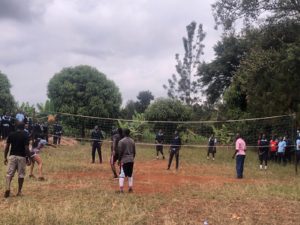
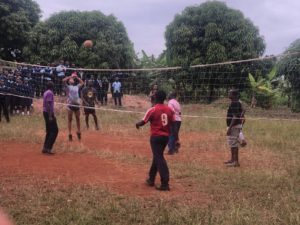
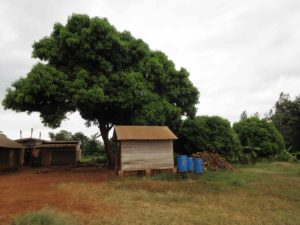
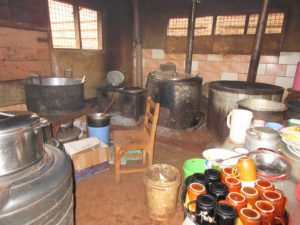
We soon headed back for to our host family’s home and assisted in cooking dinner. For dinner we had ugali, mukimo, chicken broiler, chicken kienyeji, chips (French fries) and sukuma wiki (kale).
